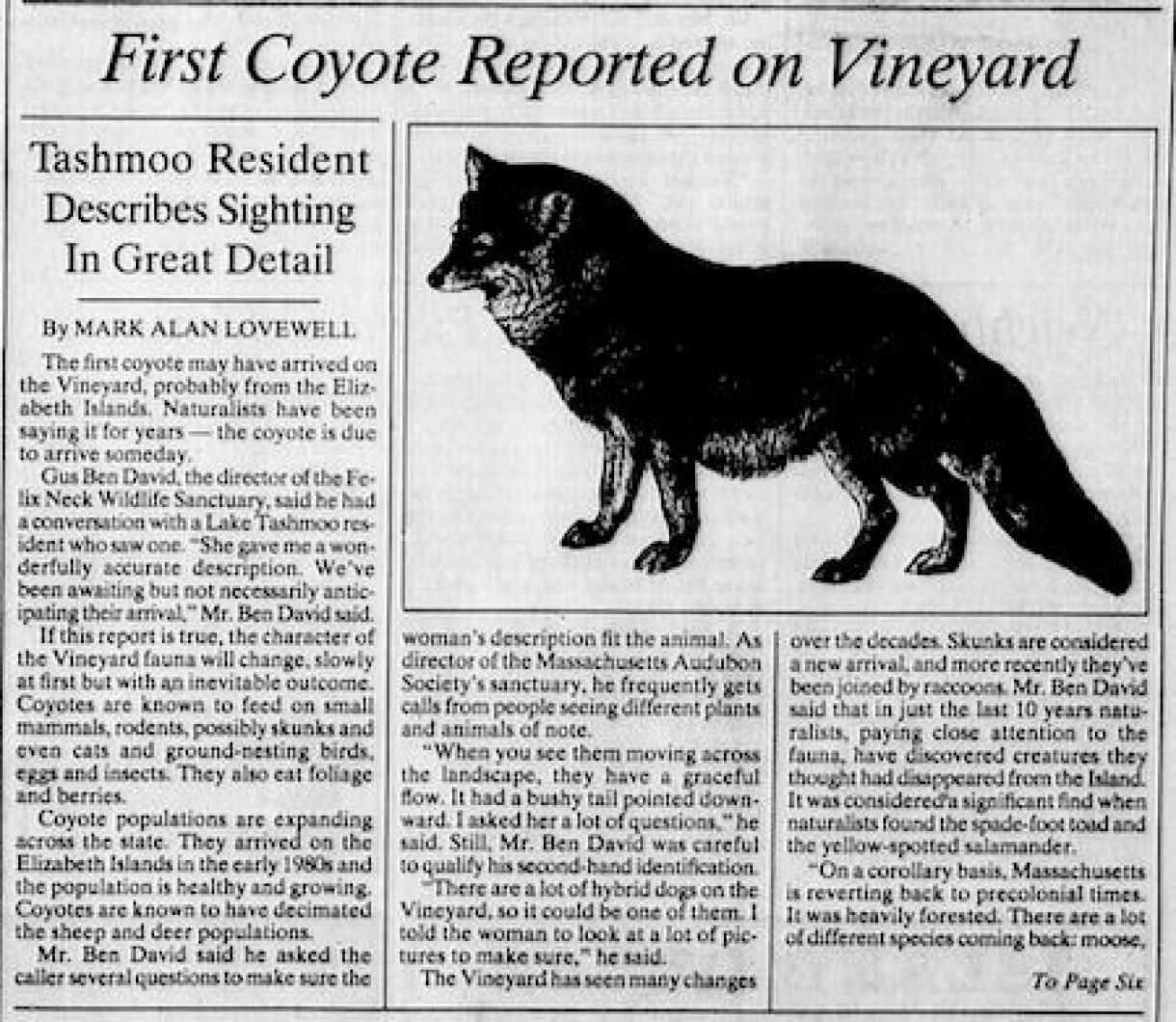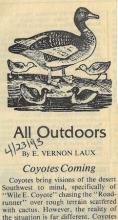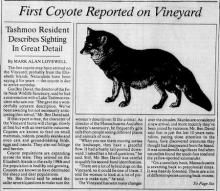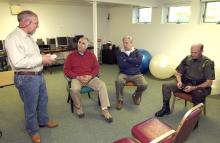The first coyote may have arrived on the Vineyard, probably from the Elizabeth Islands. Naturalists have been saying it for years - the coyote is due to arrive someday.
Gus Ben David, the director of the Felix Neck Wildlife Sanctuary, said he had a conversation with a Lake Tashmoo resident who saw one. “She gave me a wonderfully accurate description. We’ve been awaiting but not necessarily anticipating their arrival,” Mr. Ben David said.
If this report is true, the character of the Vineyard fauna will change, slowly at first but with an inevitable outcome. Coyotes are known to feed on small mammals, rodents, possibly skunks and even cats and ground-nesting birds, eggs and insects. They also eat foliage and berries.
Coyote populations are expanding across the state. They arrived on the Elizabeth Islands in the early 1980s and the population is healthy and growing. Coyotes are known to have decimated the sheep and deer populations.
Mr. Ben David said he asked the caller several questions to make sure the woman’s description fit the animal. As director of the Massachusetts Audubon Society’s sanctuary, he frequently gets calls from people seeing different plants and animals of note.
“When you see them moving across the landscape, they have a graceful flow. It had a bushy tail pointed downward. I asked her a lot of questions,” he said. Still, Mr. Ben David was careful to qualify his second-hand identification.
“There are a lot of hybrid dogs on the Vineyard, so it could be one of them. I told the woman to look at a lot of pictures to make sure,” he said.
The Vineyard has seen many changes over the decades. Skunks are considered a new arrival, and more recently they’ve been joined by raccoons. Mr. Ben David said that in just the last 10 years naturalists, paying close attention to the fauna, have discovered creatures they thought had disappeared from the Island. It was considered a significant find when naturalists found the spade-foot toad and yellow-spotted salamander.
“On a corollary basis, Massachusetts is reverting back to precolonial times. It was heavily forested. There are a lot of different species coming back: moose, wolves, and now black bears. There is a succession of agriculture to woodlands and the moose is coming back to Massachusetts from Maine and Canada,” Mr. Ben David said.
This past week a squirrel was sighted on Chappaquiddick for the first time, the result of the Island’s maturing forests.
“Years ago we had foxes on the Island. We haven’t had a fox report in 15 to 20 years. I saw one myself in both Gay Head and Edgartown. But we never had a voucher specimen, never got a photograph, or a skull, skin or carcass,” Mr. Ben David said.
The arrival of the coyote will have a major impact on the wildlife of the Island, for the animal feeds on 90 per cent of marine mammals. They are known to feed on the eggs of ground-nesting birds. Scientists believe a population of coyotes would grow rapidly, as there is plenty of food and no known predators.
Tom Chase, Island programs director for The Nature Conservancy, said: “Because of our work on Nashawena Island, I have heard stories of how the coyotes will migrate relatively routinely between the islands. I am not surprised about the report. It was only a matter of time.”
It could be a few years or many before coyotes are breeding on the Island. Once established here, he said, it seems unlikely they will ever be eradicated. Coyotes may be a possible predator of skunks, which might delight some, and house cats, which will upset others. “Coyotes will go after the best and easiest food,” Mr. Chase said. “They will probably have an impact on ground-nesting birds of all sorts, anything from the towhees to the harriers.”
Mr. Chase is more concerned about the flora and fauna that man has introduced. “If someone releases an animal on an Island, that is of great concern. It probably doesn’t belong here. But if it makes it here on its own, it is a matter of time.
“Skunks are not native. Bittersweet is not native. Coyotes, if they made it here on their own, are part of the history, part of our landscape,” he said.









Comments